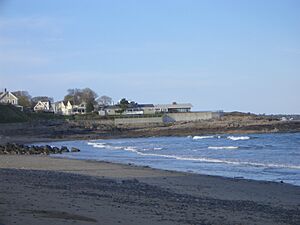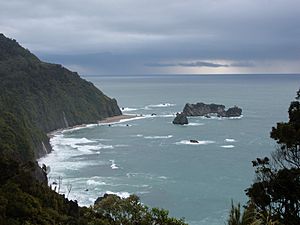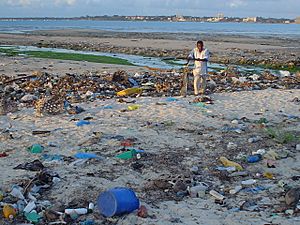Coast facts for kids
A coastline or a seashore is the place where land meets the sea or ocean. It can also be the boundary between land and a large lake. The area where the land and sea interact is called the coastal zone.
We often use the word "coast" to describe a place. For example, the West Coast of New Zealand is a well-known coastal area. The East and West Coasts of the United States are also long coastlines. If a house is "on the coast," it means it is very close to the sea. When we talk about a long stretch of land next to the sea, we call it a "coastline."
Waves are very powerful. They constantly shape the coastline as they crash onto the shore. Bigger waves have more energy. This energy can move a lot of sand and rocks. Coastlines with long, flat shores allow waves to spread out their energy. But if a coast has cliffs, the waves hit them directly. This high energy can push air and water into cracks in the rocks. Over time, this breaks the rocks apart, changing the shape of the coast.
Coasts are always changing. Natural events like sea level rise, strong waves, and different weather patterns cause these changes. They can lead to erosion, where land is worn away. They can also cause accretion, where new land is built up. Sometimes, coastal areas can flood. This can even create new continental shelves under the sea.
Contents
Why Coasts Are Important
The coast and its nearby areas are a vital part of the local ecosystem. An estuary is where fresh water from rivers mixes with salt water from the sea. This creates brackish water, which is full of nutrients. These nutrients help many kinds of marine life to grow.
Salt marshes and beaches are also important. They are home to many different plants, animals, and insects. All these living things are crucial parts of the food chain. They help keep the coastal environment healthy and balanced.
How People Use Coasts

More and more people around the world live near coastal regions. Many large cities are built on or close to good harbors. These cities often have important port facilities for ships. Even some places far from the sea have built canals to connect to the coast. This allows them to become ports too.
Coasts have always been important for defense. Countries protect their coastlines from invaders, smugglers, and illegal migrants. Many nations have built coastal defenses like forts. Most coastal countries also have a navy and a coast guard to protect their waters.
Coasts, especially those with beaches and warm water, are very popular with tourists. In many island nations, like those in the Mediterranean or Caribbean, tourism is a huge part of their economy. Coasts offer many fun activities. These include swimming, fishing, surfing, boating, and sunbathing. Managing the growth of coastal towns can be hard for local authorities. They often struggle to provide enough infrastructure for all the new residents and visitors.
Threats to Coasts
Coasts also face many problems caused by people. These are called human-induced environmental impacts. For example, human activities are believed to contribute to climate change. This causes sea level rise to speed up. Rising sea levels threaten many coastal habitats. Scientists believe that melting Arctic ice will cause sea levels to rise even more. This could flood many coastal areas around the world.
Coastal Wildlife
Animals of the Coast
Many interesting animals live along coastlines. You might find puffins, sea turtles, and rockhopper penguins. Small creatures like sea snails and various kinds of barnacles live on the rocks. They eat food brought in by the sea. In developed areas, some coastal animals, like dolphins and seagulls, are used to seeing humans.
Many types of seabirds live on the coast. Pelicans and cormorants often join terns and oystercatchers. They all look for fish and shellfish to eat. You can even find sea lions on the coast of Wales and other countries.
Plants of the Coast
Coastal areas are famous for their kelp beds. Kelp is a type of seaweed that grows very fast. It can grow up to a meter (about 3 feet) in a single day! Corals and sea anemones are actually animals, but they often stay in one place like plants. Mangroves are important trees that grow in tropical coastal areas. Seagrasses and salt marsh plants are also key types of coastal plants found in different climates.
Related pages
Images for kids
-
Rugged coastline of the West Coast Region of New Zealand
-
Southeast coast of Greenland
-
Somalia has the longest coastline in Africa.
-
Paddy fields by the coast of Fengbin, Hualien
-
Houses close to the coast, like these in Tiburon, California, may be especially desirable properties.
See also
 In Spanish: Costa para niños
In Spanish: Costa para niños












